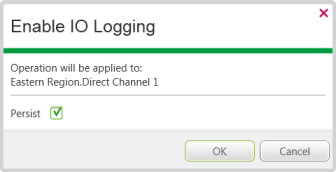I/O log files can be very useful when attempting to diagnose the cause of unexpected communication problems. If you experience communications problems on your system, Schneider Electric support staff may request that you enable I/O logging and provide the resultant log file.
To maximize system performance, you should only enable I/O logging on a channel when required. You should disable I/O logging at other times.
When you have finished monitoring the communications, we advise that you disable the logging feature. This helps to ensure better system performance and that available disk space is optimized.
To enable or disable I/O logging on a channel:
- Run ViewX and log on.
NOTE: To enable or disable I/O logging for a channel, you need to log on via a user account that has the Diagnostics permission.
- Display the Database Bar (see Display an Explorer Bar in the ClearSCADA Guide to ViewX and WebX Clients).
- Use the Database Bar to locate the required channel.
Alternatively, you can locate the channel in a List or on a Mimic that contains an animated representation of the channel (the Mimic item has to be associated with the channel's pick action menu).
- Right-click on the channel (select the channel if you are using a List or Mimic).
A context-sensitive menu is displayed. - Either:
- Select the Enable IO Logging option.
The Enable IO Logging window is displayed. 
- Use the Enable IO Logging window to determine whether the IO logging continues until it is disabled manually:
- Select the Persist check box to set IO logging so that it remains enabled until it is explicitly disabled. IO logging will remain enabled even after the driver stops or a changeover occurs.
- Clear the Persist check box to temporarily enable IO logging—IO logging is enabled but will end when the driver stops or a changeover occurs.
- Select the OK button.
An IO log file is generated. It contains details about the communications via the selected channel from the current time. - Or:
- Select the Disable IO Logging option.
The current log file will be closed and no further log files will be created (see Enable or Disable I/O Logging on a Channel).
- Select the Disable IO Logging option.
- Select the Enable IO Logging option.
When you have enabled logging for the channel, you can proceed to Display a Channel's I/O Log File.